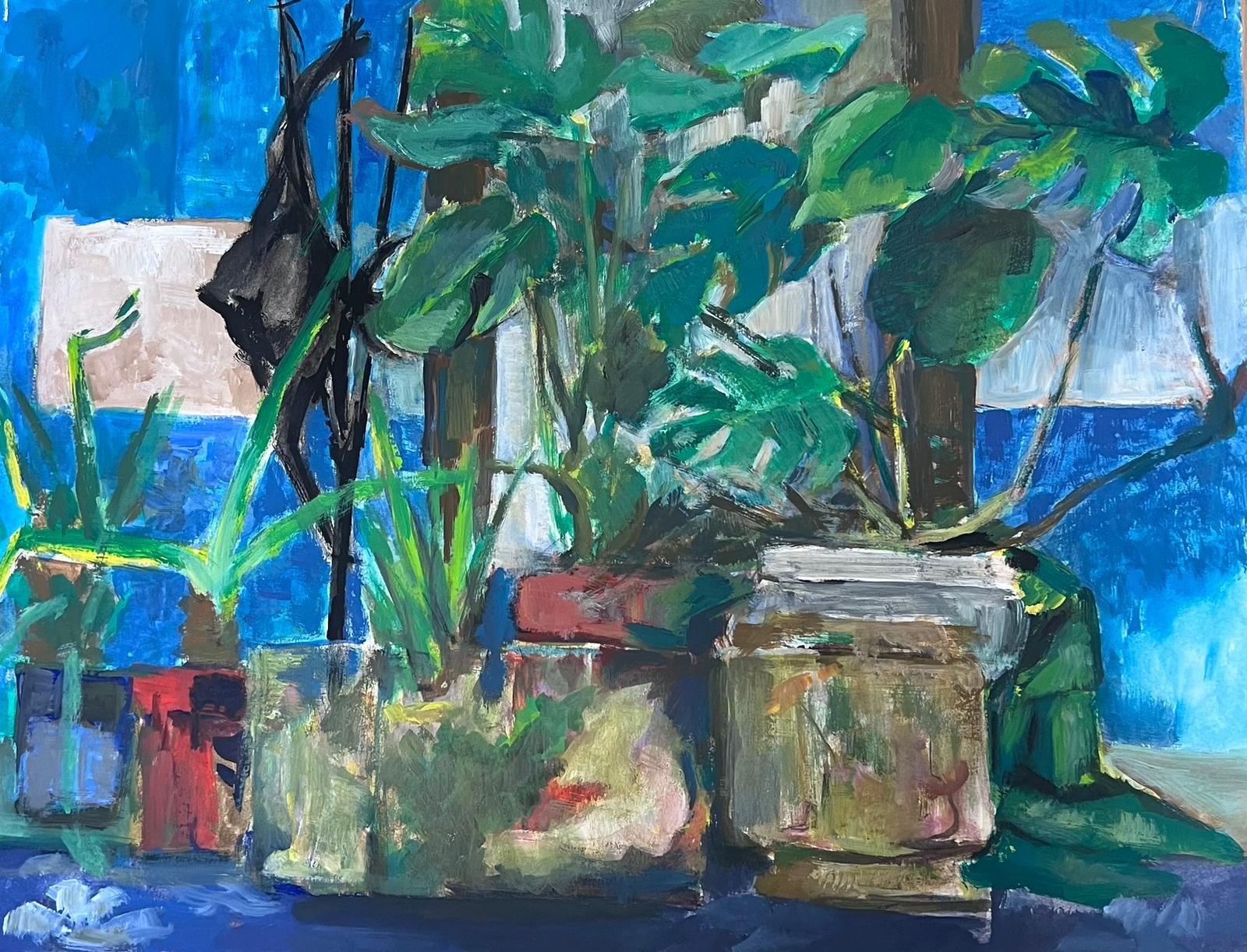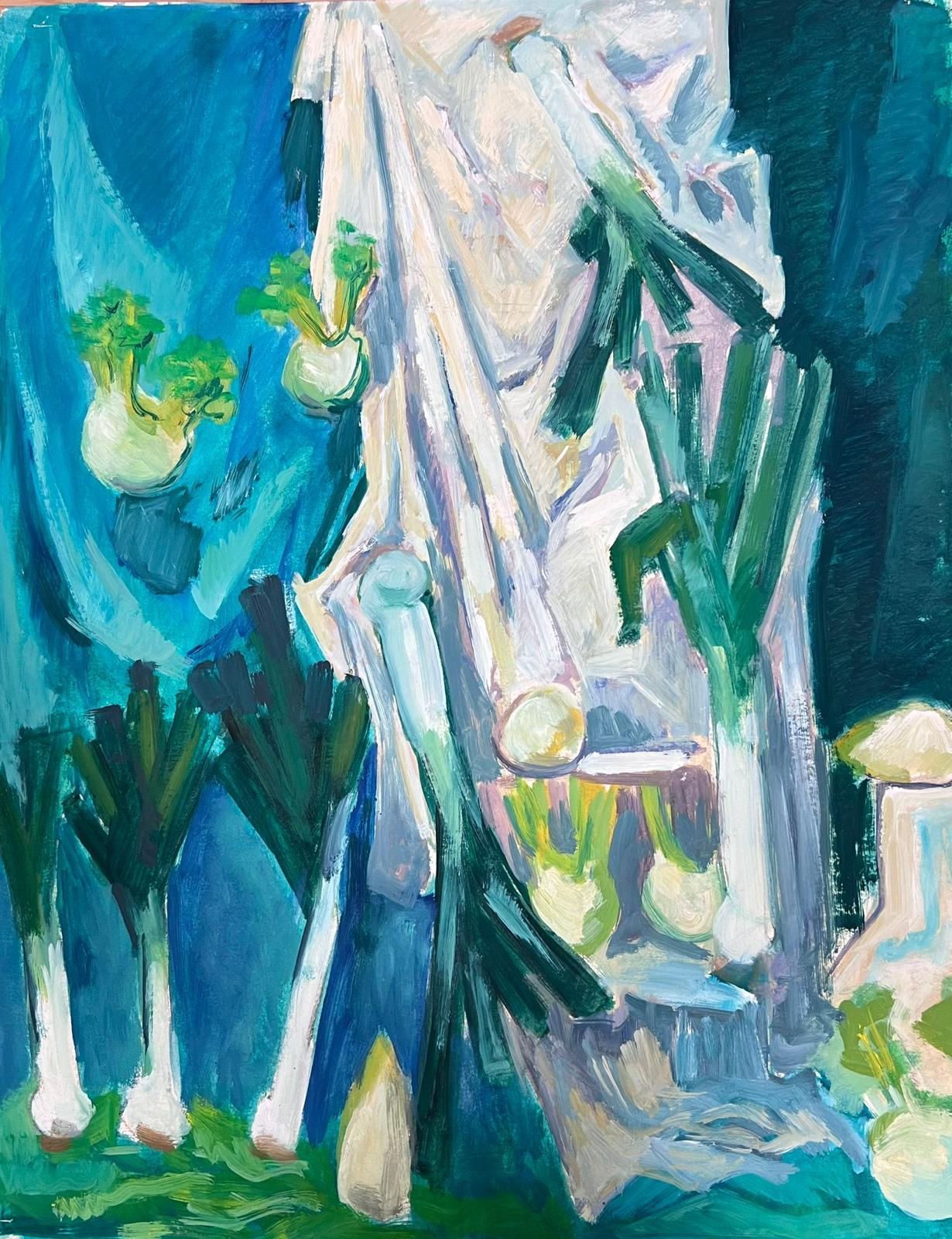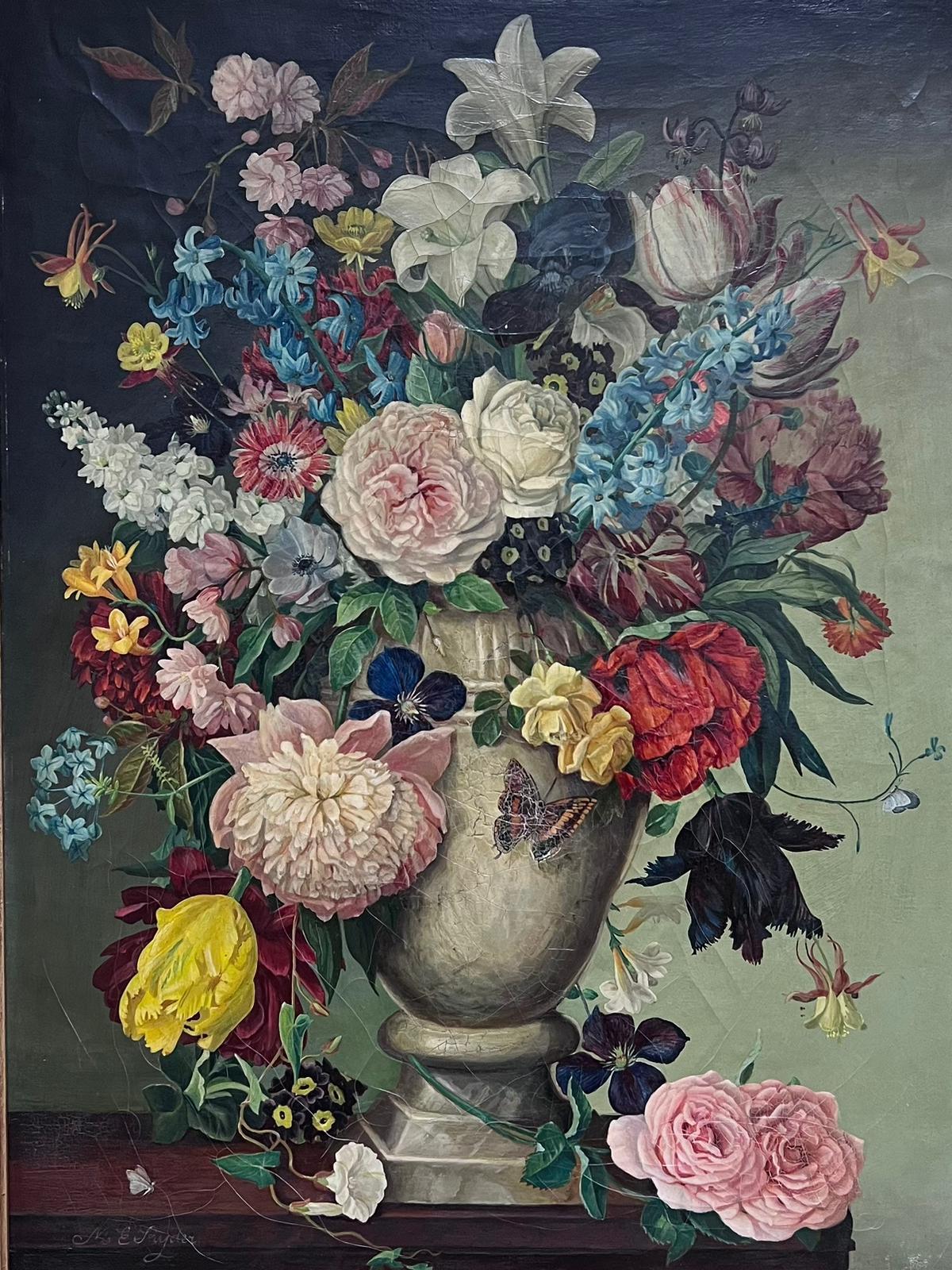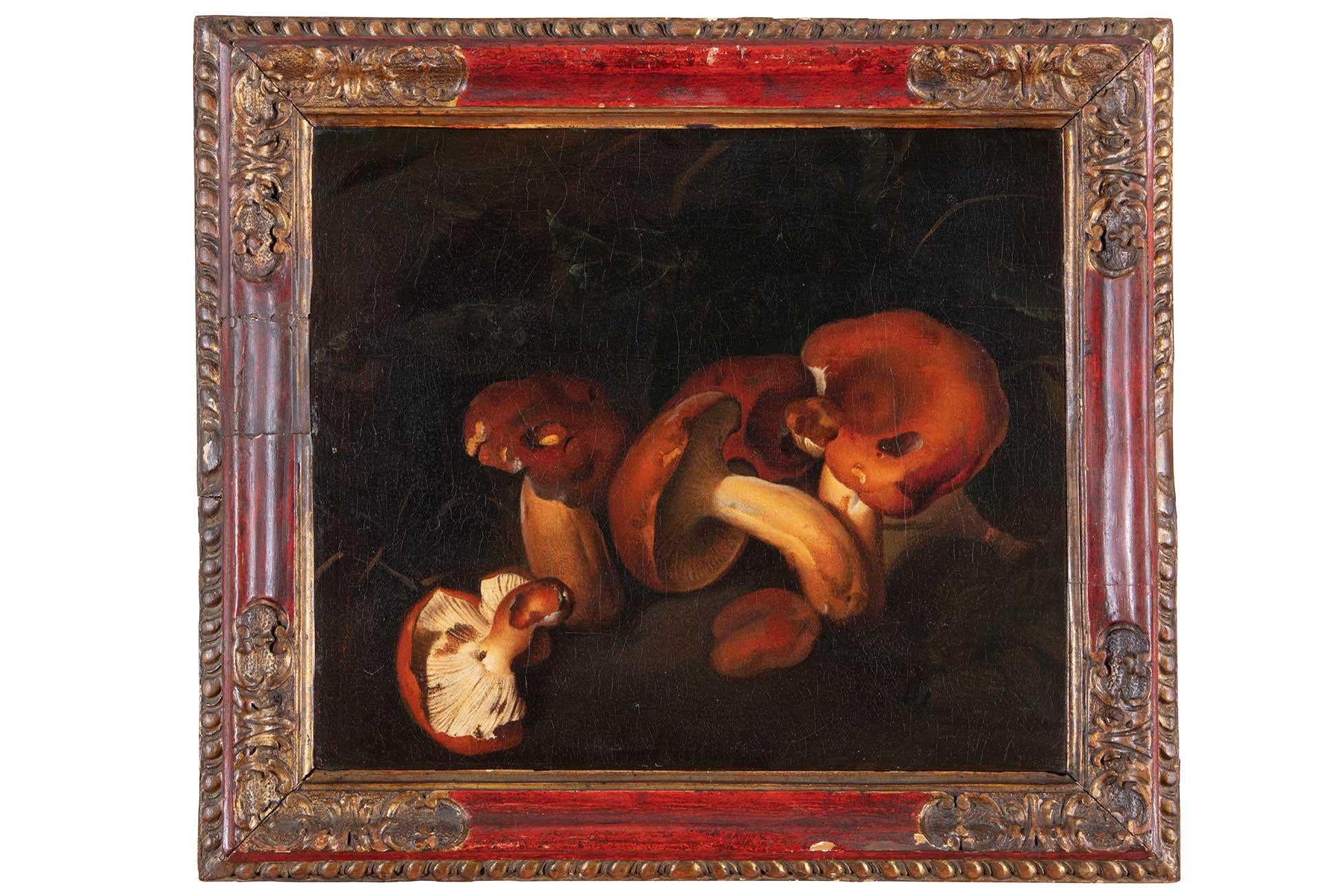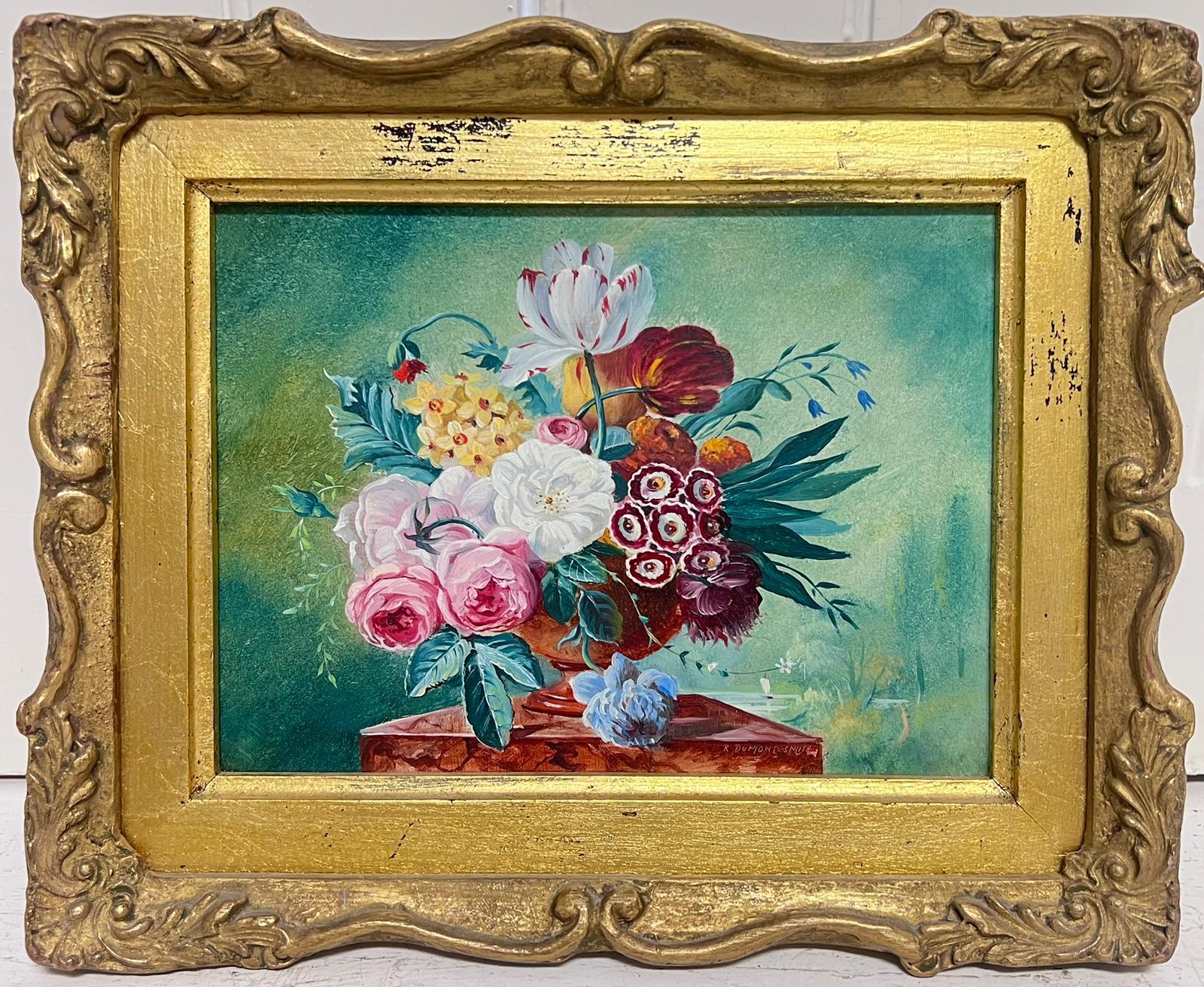Items Similar to Flower Garland Virgin Paint Oil on canvas Old master 17th Century Italy
Want more images or videos?
Request additional images or videos from the seller
1 of 17
Flower Garland Virgin Paint Oil on canvas Old master 17th Century Italy1640- 1680
1640- 1680
About the Item
Giovanni Stanchi (Rome 1608 - 1675) or Niccolò Stanchi (Rome 1623 - 1690), workshop of
GARLAND OF FLOWERS WITH PORTRAIT OF THE VIRGIN
Rome, First half of the Seventeenth century
oil on canvas, cm. 73 x 59
framed cm. 98 x 82
The examined painting is to be ascribed to the production of Giovanni Stanchi's atelier (Rome 1608 - 1675); The 'Stanchi' (the founder Giovanni, together with the brothers Niccolò and Angelo) constituted one of the most fervent still life workshops in Baroque Rome starting from 1630, sought after by the most important families of the aristocracy, from the Colonna, to the Chigi, to the Rospigliosi , and present since the end of the century in the Medici collections.
Their production, extremely varied in type but coherently stylistic, can be subdivided according to the subjects proposed: first of all the garlands, of which the proposed canvas represents an example of quality, linked to the Flemish model made famous in Rome by Daniel Seghers, and probably largely related to Giovanni; The style of the work may well approach the works of Niccolò, active in Rome for almost the entire seventeenth century, younger brother and owner of the workshop after Giovanni's death.
As for the portrait of the Virgin at the center of the garland, it must be said that, in this type of composition, the figures were often entrusted to a specialized painter, different from the painters of flowers. Carlo Maratta, for example, often collaborated with some important workshops, including Stanchi and Mario Nuzzi, completing their floral compositions with his religious subjects (see details).
This is the case, by way of example, of the magnificent mirrors performed by Giovanni Stanchi in 1670 for the gallery of Palazzo Colonna in collaboration with Carlo Maratta (Garland of flowers with four cherubs; and Vase of flowers with five cherubs), in competition with Mario dei Fiori, author of the other two; as for Nicolò, the younger brother who owned the shop after Giovanni's death, the mirrors in the Borghese palace, executed in 1675 in collaboration with Ciro Ferri.
CONSERVATION Our flower composition stands out for its bright colors and excellent preservation
Like all our objects, the work is sold with a certificate of photographic authenticity in accordance with the law.We handle and organize the transport of the purchased works, both for Italy and abroad, through professional and insured carriers.
Contact us for any information, we will be happy to answer you.
- Creation Year:1640- 1680
- Dimensions:Height: 38.59 in (98 cm)Width: 32.29 in (82 cm)
- Medium:
- Movement & Style:
- Circle Of:Giovanni Stanchi (1608 - 1675, Italian)
- Period:
- Condition:
- Gallery Location:Riva del Garda, IT
- Reference Number:1stDibs: LU98815507102
About the Seller
4.8
Platinum Seller
These expertly vetted sellers are 1stDibs' most experienced sellers and are rated highest by our customers.
Established in 2017
1stDibs seller since 2018
202 sales on 1stDibs
Typical response time: <1 hour
- ShippingRetrieving quote...Ships From: Riva del Garda, Italy
- Return PolicyA return for this item may be initiated within 7 days of delivery.
Auctions on 1stDibs
Our timed auctions are an opportunity to bid on extraordinary design. We do not charge a Buyer's Premium and shipping is facilitated by 1stDibs and/or the seller. Plus, all auction purchases are covered by our comprehensive Buyer Protection. Learn More
More From This SellerView All
- De Wit Flowers Still life Paint Oil on canvas 18th Century Flemish Cupids ArtLocated in Riva del Garda, ITJacob De Wit (Amsterdam, 1695 - 1754) attributable/ workshop Pair of Cupids with Garland of Flowers Oil on canvas 91 x 103 cm. - Framed 104 x 115 cm. Provenance: Christie's (London, Old master Painting 12.12.1996) lot 82 This magnificent composition depicts two cupids holding a garland of flowers, placed on a fine architecture with bas-reliefs and masks, presumably the top of a fountain. One of the two cupids sympathetically holds a part of it with his hands, while his head turns towards the viewer; the second cupid, on the other hand, must have clumsily broken the thread holding its end, and is sitting sullenly with a torch and a tear streaking his chubby cheek. The work, given its stylistic features and compositional taste, can be attributed to the Flemish artist Jacob de Wit (Amsterdam, 1695 - 1754), or to an artist from his workshop, with his typical triumphal and opulent style, which reveals clear influences from Rubens and Van Dijck, but also from Gerard de Lairesse...Category
18th Century Old Masters Paintings
MaterialsOil
- Flower Still-life Virgin Trevisani Stanchi Paint Oil on canvas 17/18th CenturyBy Francesco Trevisani (Capodistria 1656 - Rome 1746)Located in Riva del Garda, ITFlower garland with a portrait of the Virgin Francesco Trevisani (Capodistria 1656 - Rome 1746) and Niccolò Stanchi (Rome 1623 - 1690), attributable Oil on canvas 66 x 49 cm. - In f...Category
18th Century Old Masters Still-life Paintings
MaterialsOil
- Still-life Flower Paint Oil on canvas Old master 17th Century Lombard schoolLocated in Riva del Garda, ITFrancesca Volò Smiller, called Vincenzina (Milan, 1657 - 1700) - circle of Floral composition Oil on canvas (97 x 72 cm. - in octagonal frame 100 x 84 cm.) A rich floral compositio...Category
17th Century Old Masters Paintings
MaterialsOil
- Still Life Vanitas Noletti Paint Oil on canvas Old master 17th Century ItalianLocated in Riva del Garda, ITFrancesco Noletti known as the Maltese (Malta 1611-Rome 1654) Workshop/circle of Still life with musical instruments, toys, armour, textiles and precious objects Oil on canvas (52 x...Category
17th Century Old Masters Paintings
MaterialsOil
- Angels Flower Garzi Paint Oil on canvas Old master 17/18th Century Italian ArtBy Luigi Garzi (Pistoia 1638– Rome1721)Located in Riva del Garda, ITRoman school of the early 18th century Luigi Garzi (Pistoia 1638– Rome1721) attributed Still life of fruit supported by three angels Oil on oval canvas 116 x 91 cm., Framed 140 x 119 cm. Authentication on a photograph by Prof Giancarlo Sestieri, who attributes the work to the sphere of Luigi Garzi This magnificent canvas, depicting a sumptuous composition of fruit supported by three prosperous winged cherubs, from which comes a parchment bearing the Latin expression "Amor est vitae essentia", is to be placed in the production of a Roman author active between the second half of XVII century and the first of the following century. The iconography that sees represented cherubs with fruit or flowers is frequent in the Baroque period, especially in the Roman area, starting from the 1600s, with that particular depictional tendency aimed at illusionistic and frivolous images, to a type of paintings or frescoes of strong value decorative, intended for the private context and depicting jubilation of cherubs, angels or cherubs, and of which our canvas represents a perfect example. We can recall, among the most illustrious iconographic precedents, the elegant mirrors painted by Mario Nuzzi and Carlo Maratta that adorn the hall of Palazzo Colonna in Rome, and again the canvas preserved in the Rouen museum and the similar ones in Palazzo Chigi in Ariccia, with the collaboration for the figurative parts of Filippo Lauri. The commercial and furnishing success of similar works is also testified by authors such as Guglielmo Cortese known as Borgognone (1628 - 1679), Franz Werner Von Tamm (1658 - 1724), Giovan Battista Gaulli (1639 - 1709), Giovanni Paolo Castelli known as Spadino (Rome 1650 - 1740) and the aforementioned Carlo Maratta (1625 - 1713) The work, studied by Giancarlo Sestieri, was brought closer to the sphere of the eclectic Pistoian painter Luigi Garzi, one of the protagonists of Roman painting in the decades of transition between the seventeenth and eighteenth centuries. In our painting we can find the typical elements of his painting: the soft and delicately chiaroscuro light, the sculptural classicism of the figures as well as the stupendous luministic and chromatic effects. Luigi Garzi's training and artistic activity took place in the Eternal City and he was in effect a Roman artist. He moved to Rome from Pistoia, his hometown at a very young age, and joined the atelier of Andrea Sacchi, who directed his studies towards classicism, comparing himself with the works of Raphael, Domenichino and Nicolas Poussin, but also with the Emilian one. , with particular attention to the school of Guido Reni. But the Emilian examples were undoubtedly preceded, particularly by Giovani Lanfranco, who modeled his taste and style, together with a modulated cortonism, while those pre-eighteenth-century sensibilities are due to the lesson of Carlo Maratta. However, there is no doubt that the painter oriented his personality without ever bowing to imitation, reaching a refined elegance and autonomy of language, as the canvas in question clearly demonstrates in which the different influences find a refined amalgamation in perfect harmony with the baroque evolution between the seventeenth and eighteenth centuries, indicating a dating to its earliest maturity. These attitudes led the painter to obtain awards and prestigious commissions as soon as possible, such as the frescoes of Palazzo Borghese...Category
Late 17th Century Old Masters Paintings
MaterialsOil
- Flowers Paint Oil on canvas Old master 17th Century Italy Still-life ArtLocated in Riva del Garda, ITMaster of the Grotesque Vase (active in Rome and Naples in the first quarter of the 17th century) Still life of flowers in a classic vase oil on canvas 66 x 51 cm, In frame cm. 82 x...Category
17th Century Old Masters Paintings
MaterialsOil
You May Also Like
- Still Life of Flowers in a Vase late Victorian 19th Century Hippolyte DelanoyBy Hippolyte Pierre DelanoyLocated in Lincoln, GBHippolyte Pierre Delanoy (1849-1899) A Study of Flowers 1874 Signed and Dated, Oil on Canvas, 57 x 49cm Delanoy was born in Glasgow, of French Parents and was the brother of painter...Category
Late 19th Century Old Masters Still-life Paintings
MaterialsOil
- Still life painting of fruit in a basketLocated in London, GBStill life painting of fruit in a basket Continental, c. 1800 Frame: Height 81cm, width 91cm, depth 7cm Canvas: Height 57cm, width 69cm, ...Category
Late 18th Century Old Masters Still-life Paintings
MaterialsCanvas, Oil
- 17th century By Dutch maestro Still life with bird, carp & lobster Oil on canvasLocated in Milano, LombardiaThis painting fits well into the Dutch pictorial production of the Golden century. The composition, built on the harmonious presentation of rich wild game and fine details such as th...Category
17th Century Old Masters Still-life Paintings
MaterialsCanvas, Oil
- Antique French Still Life of Flowers in Vase Signed Oil Painting on CanvasLocated in Cirencester, GloucestershireClassical Still Life of Flowers in a Vase French School, circa 1900 signed oil on canvas, unframed canvas: 22 x 18 inches provenance: private collection, France condition: very good ...Category
Early 20th Century Old Masters Still-life Paintings
MaterialsOil
- Flower Garland by Giovanni Stanchi, the most Flemish Italian flower painterBy Giovanni StanchiLocated in PARIS, FRThis painting is reproduced in the reference book on Roman still life "Pittori di nature morta a Roma - artisti italiani 1630 -1750" by Gianluca and Ulisse Bocchi - Arti Grafiche Cas...Category
17th Century Old Masters Still-life Paintings
MaterialsCanvas, Oil
- "Cesta de flores", 17th Century Oil on Canvas, Still Flowers by Juan de ArellanoBy Juan de ArellanoLocated in Madrid, ESJUAN DE ARELLANO Spanish, 1614 - 1676 Cesta de Flores signed Juan de Arellano (lower lright) oil on canvas original period carved, gilt and polychrome...Category
17th Century Old Masters Still-life Paintings
MaterialsCanvas, Oil
Recently Viewed
View AllMore Ways To Browse
Antique Flower Art
All Master Paintings
Flower Oil Paint
Old Weller Antique
Old Wellers Antique
Old Flower
Canvas Painted Flowers
Old Paintings Oil Canvas
Old Italian Antique
Italian Master Painting
Old Famous Art
Old Masters Framed
Old Masters Painters
Old Master Style
Italian Masters Oil
Old Masters Italy
Paintings Italian Old
Oil On Canvas Old Masters
